|
Medicines for People With Diabetes
General Information
Do I need to take diabetes medicine?
What if I have type 1 diabetes?
Type 1 is the type of diabetes that people most often get before 30 years of age. All people with type 1 diabetes need to take insulin (IN-suh-lin) because their bodies do not make enough of it. Insulin helps turn food into energy for the body to work.
What if I have type 2 diabetes?
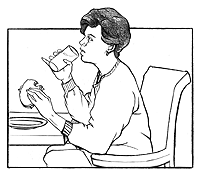 |
Healthy eating may help you lower
your blood glucose. |
Type 2 is the type of diabetes most people get as adults after the age of 40. But you can also get this kind of diabetes at a younger age.
Healthy eating, exercise, and losing weight may help you lower your blood glucose (also called blood sugar) when you find out you have type 2 diabetes. If these treatments do not work, you may need one or more types of diabetes pills to lower your blood glucose. After a few more years, you may need to take insulin shots because your body is not making enough insulin.
You, your doctor, and your diabetes teacher should always find the best diabetes plan for you.
[Top]
Why do I need medicines for type 1 diabetes?
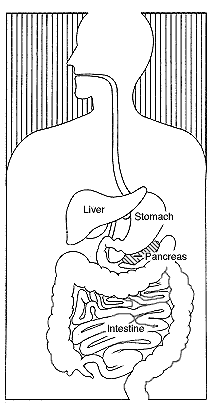 |
The pancreas is where your body makes insulin. |
Most people make insulin in their pancreas. If you have type 1 diabetes, your body does not make insulin. Insulin helps glucose from the foods you eat get to all parts of your body and be used for energy.
Because your body no longer makes insulin, you need to take insulin in shots. Take your insulin as your doctor tells you. The section What do I need to know about insulin? provides more information on insulin.
Also see: Specific Insulins
[Top]
Why do I need medicines for type 2 diabetes?
If you have type 2 diabetes, your pancreas usually makes plenty of insulin. But your body cannot correctly use the insulin you make. You might get this type of diabetes if members of your family have or had diabetes. You might also get type 2 diabetes if you weigh too much or do not exercise enough.
After you have had type 2 diabetes for a few years, your body may stop making enough insulin. Then you will need to take diabetes pills or insulin.
You need to know:
- Diabetes medicines that lower blood glucose never take the place of healthy eating and exercise.
- If your blood glucose gets too low more than a few times in a few days, call your doctor.
- Take your diabetes pills or insulin even if you are sick. If you cannot eat much, call your doctor.
|
[Top]
What do I need to know about diabetes pills?
Many types of diabetes pills can help people with type 2 diabetes lower their blood glucose. Each type of pill helps lower blood glucose in a different way. The diabetes pill (or pills) you take is from one of these groups. You might know your pill (or pills) by a different name.
- Sulfonylureas (SUL-fah-nil-YOO-ree-ahs) stimulate your pancreas to make more insulin.
- Biguanides (by-GWAN-ides) decrease the amount of glucose made by your liver.
- Alpha-glucosidase inhibitors (AL-fa gloo-KOS-ih-dayss in-HIB-it-ers) slow the absorption of the starches you eat.
- Thiazolidinediones (THIGH-ah-ZO-li-deen-DYE-owns) make you more sensitive to insulin.
- Meglitinides (meh-GLIT-in-ides) stimulate your pancreas to make more insulin.
- D-phenylalanine (dee-fen-nel-AL-ah-neen) derivatives help your pancreas make more insulin quickly.
- Combination oral medicines put together different kinds of pills.
Also see: Specific Pills
Your doctor might prescribe one pill. If the pill does not lower your blood glucose, your doctor may
- ask you to take more of the same pills, or
- add a new pill or insulin, or
- ask you to change to another pill or insulin.
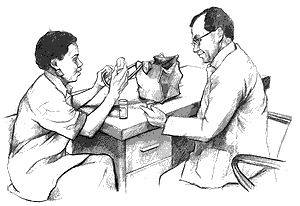 |
Tell your doctor about the side effects you feel. |
What are side effects?
- Side effects are changes that may happen in your body when you take a medicine. When your doctor gives you a new medicine, ask what the side effects might be.
- Some side effects happen just when you start to take the medicine. Then they go away.
- Some side effects happen only once in a while. You may get used to them or learn how to manage them.
- Some side effects will cause you to stop taking the medicine. Your doctor may try another one that doesn't cause you side effects.
|
[Top]
What do I need to know about insulin?
If your pancreas no longer makes enough insulin, then you need to take insulin as a shot. You inject the insulin just under the skin with a small, short needle.
Can insulin be taken as a pill?
Insulin is a protein. If you took insulin as a pill, your body would break it down and digest it before it got into your blood to lower your blood glucose.
How does insulin work?
Insulin lowers blood glucose by moving glucose from the blood into the cells of your body. Once inside the cells, glucose provides energy. Insulin lowers your blood glucose whether you eat or not. You should eat on time if you take insulin.
How often should I take insulin?
Most people with diabetes need at least two insulin shots a day for good blood glucose control. Some people take three or four shots a day to have a more flexible diabetes plan.
When should I take insulin?
You should take insulin 30 minutes before a meal if you take regular insulin alone or with a longer-acting insulin. If you take a rapid-acting insulin, you should take your shot just before you eat.
Are there several types of insulin?
Yes. There are six main types of insulin. They each work at different speeds. Many people take two types of insulin.
Does insulin work the same all the time?
After a short time, you will get to know when your insulin starts to work, when it works its hardest to lower blood glucose, and when it finishes working.
You will learn to match your mealtimes and exercise times to the time when each insulin dose you take works in your body.
How quickly or slowly insulin works in your body depends on
- your own response
- the place on your body where you inject insulin
- the type and amount of exercise you do and the length of time between your shot and exercise
Where on my body should I inject insulin?
You can inject insulin into several places on your body. Insulin injected near the stomach works fastest. Insulin injected into the thigh works slowest. Insulin injected into the arm works at medium speed. Ask your doctor or diabetes teacher to show you the right way to take insulin and in which parts of the body to inject it.
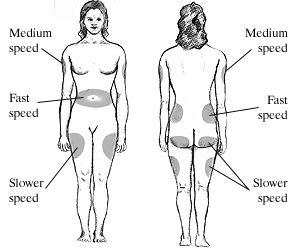 |
These are good places to give yourself insulin shots. |
|
How should I store insulin?
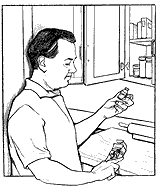 |
Keep the bottles of insulin you are using at room temperature. |
- If you use a whole bottle of insulin within 30 days, keep that bottle of insulin at room temperature. On the label, write the date that is 30 days away. That is when you should throw out the bottle with any insulin left in it.
- If you do not use a whole bottle of insulin within 30 days, then store it in the refrigerator all the time.
- If insulin gets too hot or cold, it breaks down and does not work. So, do not keep insulin in very cold places such as the freezer, or in hot places, such as by a window or in the car's glove compartment during warm weather.
- Keep at least one extra bottle of each type of insulin you use in your house. Store extra insulin in the refrigerator.
What are possible side effects of insulin?
Also see: Specific Insulins
[Top]
Might I take more than one diabetes medicine at a time?
Yes. Your doctor may ask you to take more than one diabetes medicine at a time. Some diabetes medicines that lower blood glucose work well together. Here are examples:
Two Diabetes Pills
If one type of pill alone does not control your blood glucose, then your doctor might ask you to take two kinds of pills. You may take two separate pills or one pill that combines two medicines. Each type of pill has its own way of acting to lower blood glucose. Here are pills used together:
- a sulfonylurea and metformin
- a sulfonylurea and acarbose
- metformin and acarbose
- repaglinide and metformin
- nateglinide and metformin
- pioglitazone and a sulfonylurea
- pioglitazone and metformin
- rosiglitazone and metformin
- rosiglitazone and a sulfonylurea
Diabetes Pills and Insulin
Your doctor might ask you to take insulin and one of these diabetes pills:
- a sulfonylurea
- metformin
- pioglitazone
[Top]
What should I know about hypoglycemia (low blood sugar)?
Sulfonylureas, meglitinides, D-phenylalanine derivatives, combination oral medicines, and insulin are the types of diabetes medicines that can make blood glucose go too low. Hypoglycemia can happen for many reasons:
- delaying or skipping a meal
- eating too little food at a meal
- getting more exercise than usual
- taking too much diabetes medicine
- drinking alcohol
You know your blood glucose may be low when you feel one or more of the following:
 |
You may feel dizzy or shaky when your blood glucose gets too low. |
- dizzy or light-headed
- hungry
- nervous and shaky
- sleepy or confused
- sweaty
If you think your blood glucose is low, test it to see for sure. If your blood glucose is at or below 70 mg/dL, have one of these items to get 15 grams of carbohydrate:
- 1/2 cup (4 oz.) of any fruit juice
- 1 cup (8 oz.) of milk
- 1 or 2 teaspoons of sugar or honey
- 1/2 cup (4 oz.) of regular soda
- 5 or 6 pieces of hard candy
- glucose gel or tablets (take the amount noted on the package to add up to 15 grams of carbohydrate)
Test your blood glucose again 15 minutes later. If it is still below 70 mg/dL, then eat another 15 grams of carbohydrate. Then test your blood glucose again in 15 minutes.
If you cannot test your blood glucose right away but you feel symptoms of hypoglycemia, eat one of the items listed above.
If your blood glucose is not low, but you will not eat your next meal for at least an hour, then have a snack with starch and protein. Here are some examples:
- crackers and peanut butter or cheese
- half of a ham or turkey sandwich
- a cup of milk and crackers or cereal
| 







